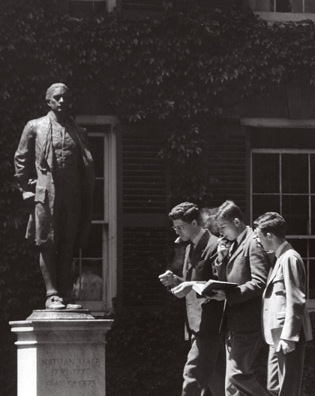 loading
loading
featuresLife at Yale During the Great DepressionGaddis Smith ’54, ’61PhD, is the Larned Professor Emeritus of History. He is writing a history of Yale in the twentieth century.  A. B. Scott, courtesy Manuscripts & ArchivesYale students stroll through the Old Campus in June 1938. View full imageIn the exuberant summer of 1929 the Dow Jones average hit one new high after another, and a Yale College senior named A. Whitney Griswold received his diploma and dashed off to Wall Street in pursuit of a fortune. Irving Fisher ’88, ’91PhD, Yale economist and national celebrity, said that stock prices had reached a “permanently high plateau.” Then, at the end of October, came the stock market crash. Griswold returned immediately to New Haven where in 1933 he earned his PhD—on the subject of the American cult of success—and joined the faculty. He would become president of the university in 1950. Fisher lost his credibility, and his personal fortune, when the stock market by 1932 had dropped 89 percent from its 1929 high. The Great Depression of the 1930s was for millions of Americans the most painful event of their lives, more so than either of the two world wars. Unemployment reached 25 percent in 1933. The material and psychological impact of lost jobs, savings, and homes was devastating. The political impact opened a chasm between those who lost whatever faith they might have had in business leadership, and who now looked to the New Deal of President Franklin D. Roosevelt for help, and those who saw the “socialist” measures of the New Deal as a threat to free enterprise and individual liberty. Yale’s two presidents during the Depression—James Rowland Angell and Charles Seymour ’08, ’11PhD—many vocal alumni, and most of the students were in the second group. For Yale the Depression had a deep and long-lasting financial effect. Even as the university saw a building boom, thanks to a bequest from John W. Sterling ’64 and a donation to underwrite the residential college system, ordinary income suffered. Although the university had avoided common stocks and kept most of the Yale endowment in bonds, income from the endowment declined by 21 percent. Gifts to the alumni fund, which had exceeded $1 million for the first time in 1926–27, dropped 85 percent to $142,732 in 1934–35. Not until 1950–51 would gifts be above $1 million again. (See “Ups and Downs of Alumni Giving.”) Between 1931 and 1935 Yale cut its expenditures by leaving vacant faculty positions unfilled, by not renewing many faculty one-year appointments, by putting a near freeze on promotions and salary increases, and by squeezing hourly employees hard. The number of Yale College faculty dropped from 107 in 1931 to 90 in 1932 and then remained stable. The presidential salary, $25,000 a year, did not budge until the 1950s. The Corporation also contemplated cutting faculty salaries, but refrained when Seymour said, “The welfare of the institution depends upon the maintenance of our prestige in comparison with Harvard, Columbia, and Princeton. . . . [We] cannot afford to take the lead in a cut at a time when our sister universities somehow or other find the means to avoid it.” With university student enrollment falling—from 6,190 in 1929-30 to 5,362 in 1934–45—President Angell in 1932, and again in 1935, urged the admission of more freshmen and transfer students. In 1933 over 100 applicants with inferior academic records were admitted as freshmen. Predictably, they did badly: a third were dropped and others fell short of promotion to sophomore year. In 1936, Edward S. Noyes ’13, chair of the board of admission, refused to repeat the experiment lest Yale admit “too large a proportion of candidates who are undesirable either racially [i.e., Jewish] or scholastically.” Economic conditions were not too bad for tenured faculty. Even as salaries remained stagnant, deflation boosted their purchasing power. Senior faculty could employ a servant for $5 a week plus food and a room on the third floor. The price of a bushel of potatoes at a farm stand was $1. Many faculty sent their children to public school, and the academic standards of New Haven's Hillhouse High School were equal to those of the best prep schools. Seymour, provost before he became president in 1937, asked the faculty to give dollars to Yale. The gifts came in, a few as small as $2, but so did denunciations of Yale's effrontery in freezing salaries and promotions and then trying to squeeze even more from the faculty. And did an appeal from the university's chief educational officer, the gatekeeper of promotions and salaries, put unethical pressure on the faculty, especially those without tenure? Seymour promised that no record would be kept of individual gifts, but strangely the record is there in the archives. In 1938 the new provost, Edgar S. Furniss ’18PhD, abandoned the appeal.
|
|